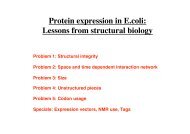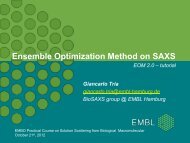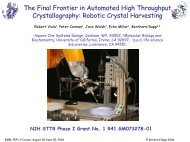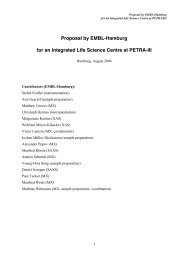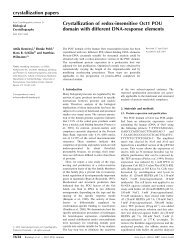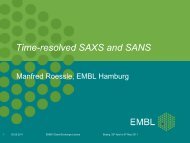Data recording, reduction and processing - EMBL Hamburg
Data recording, reduction and processing - EMBL Hamburg
Data recording, reduction and processing - EMBL Hamburg
Create successful ePaper yourself
Turn your PDF publications into a flip-book with our unique Google optimized e-Paper software.
<strong>Data</strong> <strong>recording</strong>, <strong>reduction</strong> <strong>and</strong> <strong>processing</strong><br />
Manfred Roessle<br />
<strong>EMBL</strong> <strong>Hamburg</strong>
Outline<br />
Recording of Small Angle Scattering (SAS) data<br />
SAXS Variety: Laboratory Sources <strong>and</strong> Synchrotron based SAXS Beamlines<br />
What makes SAXS Beamlines special?<br />
X-rays in <strong>and</strong> X-rays out: From the source to the detector (via the sample?)<br />
Seeking <strong>and</strong> finding: What detects what?<br />
Primary <strong>Data</strong> Reduction<br />
1-dim is 1-dim<br />
Everything has to be normalized!<br />
Subtracting nothing from something a bit more than nothing<br />
The beauty of SAXS (raw) data<br />
What the hell does this all mean?<br />
Initial parameters to judge the success of the experiment<br />
Automated SAXS data <strong>recording</strong> <strong>and</strong> analysis<br />
Let’s have a beer, we are automated!<br />
2 26.10.2010<br />
EMBO Workshop on solution scattering <strong>EMBL</strong> <strong>Hamburg</strong> 25.10 to 01.11.2010
3<br />
SAXS Synchrotron based<br />
At all running synchrotron source are SAXS beamlines available!<br />
At all new constructed synchrotrons SAXS beamlines are planned!<br />
All SAXS beamlines are highly oversubscribed <strong>and</strong> “working horses” on their<br />
facilities!<br />
The scientific applications ranging from soft condensed matter, nano-science <strong>and</strong><br />
fiber diffraction on ordered biological systems up to structural biology in solution.<br />
HASYLab, <strong>Hamburg</strong> ESRF, Grenoble<br />
Soleil, Orsay<br />
26.10.2010<br />
APS, Chicago<br />
Diamond, Didcot<br />
EMBO Workshop on solution scattering <strong>EMBL</strong> <strong>Hamburg</strong> 25.10 to 01.11.2010<br />
SPring 8, Hyogo<br />
Petra III, <strong>Hamburg</strong>
4<br />
SAXS Lab sources<br />
Bruker NanoStar<br />
Bruker NanoStar<br />
Anton Paar SAXSess<br />
Rigaku S-Max3000<br />
Hecus SAXSeye<br />
26.10.2010<br />
EMBO Workshop on solution scattering <strong>EMBL</strong> <strong>Hamburg</strong> 25.10 to 01.11.2010
5<br />
The Electromagnetic Spectrum<br />
26.10.2010<br />
EMBO Workshop on solution scattering <strong>EMBL</strong> <strong>Hamburg</strong> 25.10 to 01.11.2010
6<br />
Radiation from Synchrotron Storage Rings<br />
Production of X-rays<br />
Bending magnet<br />
Wiggler<br />
Undulator<br />
http://www.physics.uwa.edu.au<br />
26.10.2010<br />
Necessary part of a synchrotron. Many of<br />
these dipole magnets form the<br />
synchrotron storage ring. The electrons<br />
(positrons) are deflected <strong>and</strong> accelerated<br />
in the magnetic field. This acceleration<br />
generates the synchrotron light. The light<br />
is emitted tangential to the electron beam.<br />
Stack of magnetic dipoles. Put into the<br />
straight sections of the storage ring.<br />
Wigglers produces more light than<br />
bending magnets in a smaller source<br />
size.<br />
Most powerfull insertion device! A stack of<br />
magnetic dipoles generate a high flux of<br />
photons in a very small source size. The<br />
specific arrangement of the dipoles (d=n*λ)<br />
produces a discrete spectrum with<br />
coherent properties.<br />
EMBO Workshop on solution scattering <strong>EMBL</strong> <strong>Hamburg</strong> 25.10 to 01.11.2010
7<br />
Radiation from Synchrotron Storage Rings<br />
Dipole bending magnet (APS)<br />
26.10.2010<br />
EMBO Workshop on solution scattering <strong>EMBL</strong> <strong>Hamburg</strong> 25.10 to 01.11.2010
8<br />
Properties of X-rays from<br />
Synchrotron Sources<br />
1. High flux of photons<br />
2. Tangentially emitted with a<br />
central cone such like a<br />
spotlight<br />
3. Polychromatic light from<br />
infrared to X-rays<br />
26.10.2010<br />
X-ray optics for:<br />
1. Beam defining<br />
2. Focusing<br />
3. Monochromatization<br />
EMBO Workshop on solution scattering <strong>EMBL</strong> <strong>Hamburg</strong> 25.10 to 01.11.2010<br />
High heat load <strong>and</strong> radiation damage!<br />
Beamsize increases with distance from<br />
source point!<br />
Scattering/Diffraction experiments need<br />
monochromatic light!
9<br />
X-ray optics<br />
Beam defining<br />
Beam defining by slit pairs:<br />
From Glatter & Kratky 1982<br />
Small Angle Scattering<br />
Book online available!<br />
http://physchem.kfunigraz.ac.at/sm/Index.html<br />
Or google “Otto Glatter”<br />
26.10.2010<br />
Problem:<br />
Every edge cutting the beam produces<br />
parasitic scattering! Refractive streaks at low<br />
angles impedes SAXS experiments!<br />
Solution:<br />
Successive slit systems. First slits cutting the beam <strong>and</strong><br />
second system cuts out the undesired parasitic scattering<br />
from source<br />
Slit system 1<br />
Beam defining<br />
Slit system 2<br />
Beam cleaning<br />
to detector<br />
For slits exposed to high head load, cooling is necessary<br />
EMBO Workshop on solution scattering <strong>EMBL</strong> <strong>Hamburg</strong> 25.10 to 01.11.2010
10<br />
X-ray optics<br />
Focusing<br />
The glancing angle for X-rays on surfaces are very<br />
small. Only under grazing conditions X-ray mirrors<br />
can be used for focusing.<br />
Bending of the highly<br />
polished mirror surface<br />
permits focusing on the<br />
parabolic mirror profile<br />
26.10.2010<br />
reflectivity<br />
1<br />
0.9<br />
0.8<br />
0.7<br />
0.6<br />
0.5<br />
0.4<br />
0.3<br />
0.2<br />
0.1<br />
0<br />
Reflectivity for Rh@8keV<br />
0 0.2 0.4 0.6 0.8 1<br />
angles [deg]<br />
In order to use the full beam size X-ray mirrors on<br />
synchrotrons are typically in the range of 30cm to<br />
1m. The grazing angle can be increased by using<br />
high Z-elements (e.g. Rhodium, Platin, Nickel) as<br />
reflecting surface. These mirrors are acting as well<br />
as high energy filter; important for<br />
monochromatization<br />
EMBO Workshop on solution scattering <strong>EMBL</strong> <strong>Hamburg</strong> 25.10 to 01.11.2010
11<br />
X-ray Optics<br />
Monochromator<br />
Monochromatization of the X-ray is achieved by using single crystals in<br />
Bragg diffraction geometry<br />
26.10.2010<br />
nλ=<br />
2dsin<br />
( Θ)<br />
For instance a Si 111 crystal<br />
with d-spacing (=distance<br />
between the crystal lattice) of<br />
d=3.14 Å deflects the beam for<br />
a wavelength of λ=1 Å to Θ ~<br />
10°(9.16°).<br />
EMBO Workshop on solution scattering <strong>EMBL</strong> <strong>Hamburg</strong> 25.10 to 01.11.2010<br />
Θ<br />
Θ<br />
2Θ<br />
Problem:<br />
The Bragg condition is also fulfilled for<br />
multiple orders of the wavelength n.<br />
These higher order have to be filtered<br />
by the X-ray mirror
12<br />
X-ray optics<br />
X33 mirror<br />
1m Rh coated on Zerodur substrate<br />
26.10.2010<br />
EMBO Workshop on solution scattering <strong>EMBL</strong> <strong>Hamburg</strong> 25.10 to 01.11.2010<br />
X33 monochromator<br />
Si 111 single crystal in asymmetric<br />
cut<br />
This device is also used for horizontal<br />
focusing.
13<br />
Detectors for SAXS<br />
Seeking <strong>and</strong> finding<br />
26.10.2010<br />
Fiber optic tapered CCD cameras for X-rays.<br />
+ fast readout (10Hz framing possible)<br />
+ large area possible<br />
- low dynamic range<br />
- sensitive to overexposing<br />
- spatial correction due to the fiber optic taper<br />
- intrinsic background of CCD chip<br />
EMBO Workshop on solution scattering <strong>EMBL</strong> <strong>Hamburg</strong> 25.10 to 01.11.2010
14<br />
Detectors for SAXS<br />
Seeking <strong>and</strong> finding<br />
26.10.2010<br />
Novel pixel detectors<br />
PILATUS system Swiss light source<br />
+ high dynamic range (10 20 phot/s!!!)<br />
+ no intrinsic background<br />
+ fast framing<br />
Ideal detector for solution scattering!<br />
500k model was installed successfully at<br />
X33 <strong>and</strong> upgraded to a 1M prototype<br />
EMBO Workshop on solution scattering <strong>EMBL</strong> <strong>Hamburg</strong> 25.10 to 01.11.2010
SAXS<br />
Detector<br />
15<br />
BM4<br />
Camera Tube<br />
26.10.2010<br />
Experimental Hutch<br />
WAXS<br />
Detector<br />
Sample<br />
Area<br />
BM3<br />
Shutter<br />
Hutch Wall<br />
1.5m 1.2m 0.1m 2.2m 2.5m 0.7m<br />
2.7m<br />
X33-Beamline Schematic<br />
Not to scale<br />
Attenuator<br />
Optics Hutch<br />
SS4 SS3 SS2 Mirror SS1 Mono<br />
Aperture<br />
PS – Primary Slit SS – Secondary Slits BM – Beam Monitor<br />
31.6m<br />
EMBO Workshop on solution scattering <strong>EMBL</strong> <strong>Hamburg</strong> 25.10 to 01.11.2010<br />
0.9m<br />
BM2<br />
1.1m<br />
21.4m<br />
BM1<br />
+<br />
PS<br />
+<br />
Source
16<br />
Schematic X33 SAXS setup<br />
Beamstop with diode for measurement<br />
of transmitted beam<br />
PILATUS 1M<br />
26.10.2010<br />
1400 mm<br />
s: 0.1 nm -1 to 4.3nm -1<br />
d : 65 nm to 15 nm<br />
Pilatus WAXS detector up to 13°<br />
q~10 nm -1 d~ 6 Å<br />
1000 mm<br />
EMBO Workshop on solution scattering <strong>EMBL</strong> <strong>Hamburg</strong> 25.10 to 01.11.2010<br />
Sample cell<br />
Beamshutter<br />
with diode for<br />
measurement of<br />
incident beam<br />
(prior to<br />
exposure)
17<br />
<strong>EMBL</strong>’s X33 Beamline<br />
26.10.2010<br />
EMBO Workshop on solution scattering <strong>EMBL</strong> <strong>Hamburg</strong> 25.10 to 01.11.2010
18<br />
<strong>Data</strong> Reduction<br />
From 2-dim to 1-dim<br />
Intensity<br />
1e+5<br />
1e+4<br />
1e+3<br />
1e+2<br />
26.10.2010<br />
d<br />
0 200 400 600 800 1000 1200 1400 1600 1800 2000 2200 2400<br />
Channels<br />
Radial (azimuthal) averaging:<br />
The 2-dim detector intensities are stored as<br />
a images with three values:<br />
Intensity counts; pixel X <strong>and</strong> pixel Y<br />
I(x,y)<br />
The x=0 <strong>and</strong> y=0 position<br />
can be determined by<br />
the concentric diffraction<br />
cycles of Silver Behenate<br />
powder.<br />
EMBO Workshop on solution scattering <strong>EMBL</strong> <strong>Hamburg</strong> 25.10 to 01.11.2010
Radial Averaging<br />
Log I(s)<br />
Normalization against:<br />
• data collection time,<br />
• concentration,<br />
• transmitted sample intensity.<br />
s, nm -1
20<br />
<strong>Data</strong> Reduction<br />
Assigning the s-axis<br />
Peak order d-spacing s-value d-Channel<br />
1 st order 5.834 nm 1.076 nm -1 495<br />
2 nd order 2.917 nm 2.153 nm-1 995<br />
3 rd order 1.944 nm 3.231 nm -1 1400<br />
4 th order 1.458 nm 4.304 nm -1 1990<br />
26.10.2010<br />
2π<br />
s=<br />
sin<br />
λ<br />
1<br />
( 2Θ)<br />
=<br />
d<br />
Intensity<br />
s-value [nm -1 ]<br />
5<br />
4<br />
3<br />
2<br />
1<br />
1e+12<br />
1e+11<br />
1e+10<br />
EMBO Workshop on solution scattering <strong>EMBL</strong> <strong>Hamburg</strong> 25.10 to 01.11.2010<br />
1e+9<br />
1e+8<br />
1e+7<br />
0 500 1000 1500 2000 2500<br />
Channels<br />
0<br />
0 500 1000 1500 2000<br />
Peak position [Channels]
21<br />
Background subtraction<br />
26.10.2010<br />
St<strong>and</strong>ard protocol:<br />
1. Measurement: Buffer<br />
2. Measurement: Protein<br />
3. Measurement: Buffer<br />
EMBO Workshop on solution scattering <strong>EMBL</strong> <strong>Hamburg</strong> 25.10 to 01.11.2010<br />
We are looking to protein<br />
signals of less than 0.5%<br />
above the back- ground level!
22<br />
Primary <strong>Data</strong> Analysis<br />
Judging the data quality<br />
26.10.2010<br />
EMBO Workshop on solution scattering <strong>EMBL</strong> <strong>Hamburg</strong> 25.10 to 01.11.2010<br />
First experiment<br />
BSA st<strong>and</strong>ard solution<br />
This st<strong>and</strong>ard is used<br />
for calibration <strong>and</strong> has<br />
to be freshly prepared<br />
<strong>and</strong> measured.
23<br />
First test<br />
Quality check on intensity data<br />
Ideal solution of particles Repulsive particle interactions Attractive particle interactions<br />
26.10.2010<br />
EMBO Workshop on solution scattering <strong>EMBL</strong> <strong>Hamburg</strong> 25.10 to 01.11.2010
24<br />
Primary <strong>Data</strong> Analysis<br />
The Guinier Fit<br />
26.10.2010<br />
EMBO Workshop on solution scattering <strong>EMBL</strong> <strong>Hamburg</strong> 25.10 to 01.11.2010<br />
Comparison of two a<br />
protein sample to the BSA<br />
st<strong>and</strong>ard.<br />
The difference at low<br />
angles < 1 nm -1 because<br />
of the different molecular<br />
weights (MW).<br />
The scattering at low<br />
angles is proportional the<br />
product of c protein · MW.<br />
At known protein<br />
concentration <strong>and</strong> a<br />
proper BSA st<strong>and</strong>ard the<br />
molecular weight of the<br />
sample can be estimated<br />
using the Guinier-Fit.
25<br />
Primary <strong>Data</strong> Analysis<br />
The Guinier Fit<br />
26.10.2010<br />
Radius of Gyration Forward scattering I 0<br />
BSA st<strong>and</strong>ard 3.07 nm 185 units<br />
Sample protein 5.58 nm 867 units<br />
EMBO Workshop on solution scattering <strong>EMBL</strong> <strong>Hamburg</strong> 25.10 to 01.11.2010<br />
I(<br />
s)<br />
≅ I<br />
lnI<br />
MW<br />
MW<br />
( s)<br />
protein<br />
protein<br />
0<br />
e<br />
Rg<br />
−<br />
3<br />
≅ln<br />
I<br />
0<br />
2<br />
s<br />
Rg<br />
−<br />
3<br />
66kDa<br />
= ⋅867<br />
185<br />
2<br />
= 307kDa<br />
2<br />
s<br />
2
Protein folding state<br />
Kratky plot<br />
The Kratky plot is typically used to analyze the conformation of proteins, but can be used to<br />
analyze the r<strong>and</strong>om walk model of polymers.<br />
I(s)*s2 A Kratky plot can be made by plotting:<br />
versus s.<br />
Folded globular protein Completely unfolded protein Partially folded protein<br />
26 26.10.2010<br />
EMBO Workshop on solution scattering <strong>EMBL</strong> <strong>Hamburg</strong> 25.10 to 01.11.2010
Porod Volume<br />
Rule of thumb: Porod volume is approximately two times molecular weight<br />
Here BSA: MW 66 kDa; Porod volume 115<br />
27 26.10.2010<br />
EMBO Workshop on solution scattering <strong>EMBL</strong> <strong>Hamburg</strong> 25.10 to 01.11.2010<br />
Porod approximation:<br />
Q=<br />
I(s) = K*s -4<br />
K<br />
∝<br />
Q<br />
V<br />
∞<br />
∫<br />
s=<br />
0<br />
s<br />
S<br />
V<br />
2<br />
I(<br />
s)<br />
ds<br />
Q = Porod invariant<br />
S shape to<br />
volume ratio
28<br />
Automated SAXS data treatment “Pipeline”<br />
water.dat<br />
s-buffer1.dat<br />
sample-hi-conc.dat<br />
sample-mid-conc.dat<br />
sample-check.dat<br />
sample-lo-conc.dat<br />
s-buffer2.dat<br />
bsa-buffer1.dat<br />
bsa.dat<br />
bsa-buffer2.dat<br />
26.10.2010<br />
AUTORG<br />
AUTOSUB<br />
AUTOSUB<br />
AUTORG<br />
AUTOSUB<br />
AUTORG<br />
qual.<br />
qual<br />
.<br />
qual<br />
.<br />
.dat<br />
.dat<br />
I 0<br />
I 0<br />
.dat .out<br />
Merge AUTOGNOM DAMMIF<br />
MolMass<br />
R g ,s min<br />
MM<br />
EMBO Workshop on solution scattering <strong>EMBL</strong> <strong>Hamburg</strong> 25.10 to 01.11.2010<br />
…<br />
…
29<br />
BioSAXS sample changer evaluation setup<br />
Integrated in experiment control <strong>and</strong> analysis pipeline<br />
In user operation since 2010<br />
26.10.2010<br />
EMBO Workshop on solution scattering <strong>EMBL</strong> <strong>Hamburg</strong> 25.10 to 01.11.2010<br />
Joint project with <strong>EMBL</strong><br />
Grenoble (project leader <strong>and</strong><br />
construction of the device)<br />
<strong>and</strong> ESRF<br />
In <strong>Hamburg</strong>:<br />
Fully automated operation<br />
implemented <strong>and</strong> integrated<br />
in the analysis pipeline<br />
Filling faster than with the<br />
Fraunhofer changer<br />
35 µl sample volume (before<br />
80 µl)
Automation Results: what the users see<br />
30 26.10.2010<br />
EMBO Workshop on solution scattering <strong>EMBL</strong> <strong>Hamburg</strong> 25.10 to 01.11.2010
31<br />
Automated <strong>Data</strong> Analysis: AutoRg<br />
Estimation of radius of gyration Rg <strong>and</strong> molecular weight<br />
Solution<br />
scattering data<br />
1. Automated (no help from a user)<br />
2. Implemented into <strong>processing</strong> pipline<br />
3. Input used for Autognom<br />
26.10.2010<br />
file.dat<br />
EMBO Workshop on solution scattering <strong>EMBL</strong> <strong>Hamburg</strong> 25.10 to 01.11.2010<br />
Program autorg.exe<br />
Rg – radius of gyration<br />
σ – accuracy<br />
Io – zero angle intensity<br />
Used range<br />
Quality<br />
Petoukhov, M.V., Konarev, P.V., Kikhney, A.G. &<br />
Svergun D.I. (2007) ATSAS 2.1 - Towards Automated<br />
<strong>and</strong> Web-supported Small-angle Scattering <strong>Data</strong> Analysis.<br />
J.Appl.Cryst. 40, 223-228.
32<br />
Estimation of D max with AUTOGNOM<br />
D max underestimated D max overestimated D max ok.<br />
26.10.2010<br />
EMBO Workshop on solution scattering <strong>EMBL</strong> <strong>Hamburg</strong> 25.10 to 01.11.2010
33<br />
Automation<br />
Easy going <strong>and</strong> money is for nothing?<br />
26.10.2010<br />
Ab initio model with closed shutter!!<br />
EMBO Workshop on solution scattering <strong>EMBL</strong> <strong>Hamburg</strong> 25.10 to 01.11.2010
34<br />
Conclusions<br />
26.10.2010<br />
1. SAXS beamlines are special equipped for<br />
making excellent solution scattering<br />
experiments<br />
2. Trust the beamline automation, it is working!<br />
3. Don’t trust the beamline automation – if you<br />
find something strange going on<br />
4. Validate your results!<br />
5. Ask the beamline staff in the case of troubles –<br />
they will help you<br />
EMBO Workshop on solution scattering <strong>EMBL</strong> <strong>Hamburg</strong> 25.10 to 01.11.2010




